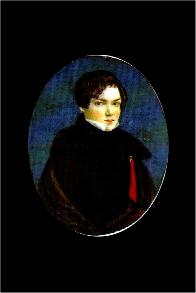op.1, F-major
composed 1829/1830
 Schumann
wrote about the Abegg Variations in his diary in 1831: “Today I unveiled
my Variations to the world for the first time! May this next period be
one of strength and inner improvement.”
Schumann
wrote about the Abegg Variations in his diary in 1831: “Today I unveiled
my Variations to the world for the first time! May this next period be
one of strength and inner improvement.”
His goal was to find a shared musical language with which his fellow humans could communicate their experiences and aspirations. This attempt can already be seen in his first published work, the Abegg Variations, op. 1. The pitches “A - B - E - G - G” (“B” being the name for “B-flat” in German) form a theme that only rarely appears in the Variations. Of much greater importance are the tritone “A - E-flat” and the motif “A - G - E-flat.” Schumann’s inspiration at this time was the married Agnes Carus (“A - G - E-flat” in German is “A - G - Es”). His love was unfulfilled and forbidden, and found transfigured expression in his music and the poetry of his diaries. The interval of the tritone “A - Es (E-flat)” expresses his tension musically, and he begins the Variations with the tritone “B (B-flat) - E.” The fictitious dedicatee Countess Pauline d’Abegg conceals the identity of Agnes Carus.
© Franz Vorraber